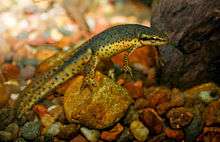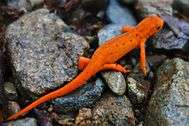Eastern newt
| Eastern newt | |
|---|---|
 | |
| Aquatic adult male | |
| Scientific classification | |
| Kingdom: | Animalia |
| Phylum: | Chordata |
| Class: | Amphibia |
| Order: | Caudata |
| Family: | Salamandridae |
| Genus: | Notophthalmus |
| Species: | N. viridescens |
| Binomial name | |
| Notophthalmus viridescens (Rafinesque, 1820) | |
 | |
| Eastern newt range | |
The eastern newt (Notophthalmus viridescens) is a common newt of eastern North America. It frequents small lakes, ponds, and streams or near-by wet forests. The eastern newt produces tetrodotoxin which makes the species unpalatable to predatory fish and crayfish.[2] It has a lifespan of 12 to 15 years in the wild, and may grow to five inches in length. These animals are common aquarium pets, being either collected from the wild or sold commercially. The striking bright orange juvenile stage, which is land-dwelling, is known as a red eft. Some sources blend the general name of the species and that of the red-spotted newt subspecies into eastern red-spotted newt (although there is no "western" one).[3][4]
Sub-species
The eastern newt includes these four subspecies:[5]
- Red-spotted newt (N. v. viridescens)
- Broken-striped newt (N. v. dorsalis)
- Central newt (N. v. louisianensis)
- Peninsula newt (N. v. piaropicola)
Life stages
Eastern newts have three stages of life: (1) the aquatic larva or tadpole, (2) the red eft or terrestrial juvenile stage, and (3) the aquatic adult.
Larva
The larva possesses gills and does not leave the pond environment where it was hatched. Larvae are brown-green in color, and shed their gills when they transform into the red eft.
Red eft
The red eft (juvenile) stage is a bright orangish-red in color, with darker red spots outlined in black. An eastern newt can have as many as 21 of these spots. The pattern of these spots differs among the subspecies. During this stage, the eft may travel far, acting as a dispersal stage from one pond to another, ensuring outcrossing in the population. The striking coloration of this stage is an example of aposematism — or "warning coloration" — which is a type of antipredator adaptation in which a "warning signal" is associated with the unprofitability of a prey item (i.e., its toxicity) to potential predators.[6]
Adult
After two or three years, the eft finds a pond and transforms into the aquatic adult. The adult's skin is a dull olive green dorsally, with a dull yellow belly, but retains the eft's characteristic black-rimmed red spots. It develops a larger, blade-like tail and characteristically slimy skin.
It is common for the peninsula newt (N. v. piaropicola) to be neotenic, with a larva transforming directly into a sexually mature aquatic adult, never losing its external gills. The red eft stage is in these cases skipped.
Homing
Eastern newts home using magnetic orientation. Their magnetoreception system seems to be a hybrid of polarity-based inclination and a sun-dependent compass. Shoreward-bound eastern newts will orient themselves quite differently under light with wavelengths around 400 nm than light with wavelengths around 600 nm, while homing newts will orient themselves the same way under both short and long wavelengths.[3] Ferromagnetic material, probably biogenic magnetite, is likely present in the eastern newt's body.[4]
Habitat and diet
Eastern newts are at home in both coniferous and deciduous forests. They need a moist environment with either a temporary or permanent body of water, and thrive best in a muddy environment. During the eft stage, they may travel far from their original location. Red efts may often be seen in a forest after a rainstorm. Adults prefer a muddy aquatic habitat, but will move to land during a dry spell. Eastern newts have some amount of toxins in their skin, which is brightly colored to act as a warning. Even then, only 2% of larvae make it to the eft stage. Some larvae have been found in the pitchers of the carnivorous plant Sarracenia purpurea.[7]
Eastern newts eat a variety of prey, such as insects, small molluscs and crustaceans, young amphibians, worms and frog eggs.
Gallery
 Terrestrial juvenile stage ("red eft")
Terrestrial juvenile stage ("red eft") Aquatic larval stage
Aquatic larval stage.jpg) Eft near Northfield, Massachusetts
Eft near Northfield, Massachusetts- Eft navigating over leaves
 Eft on North Fork Mountain in eastern West Virginia
Eft on North Fork Mountain in eastern West Virginia Eft seen along a trail in Harriman Park, New York
Eft seen along a trail in Harriman Park, New York Swollen cloaca and large hind legs in a reproductive adult male
Swollen cloaca and large hind legs in a reproductive adult male Adult female central newt
Adult female central newt
References
Citations
- ↑ IUCN SSC Amphibian Specialist Group 2014. Notophthalmus viridescens. The IUCN Red List of Threatened Species. Version 2014.3. Downloaded on 14 November 2014.
- ↑ Marion, Zachary; Hay, Mark (2011). "Chemical Defense of the Eastern Newt (Notophthalmus viridescens): Variation in Efficiency against Different Consumers and in Different Habitats". PLOS ONE. 6 (12). doi:10.1371/journal.pone.0027581.
- 1 2 Phillips, J. and S. C. Borland. (1994). Use of a specialized magnetoreception system for homing by the eastern red-spotted newt Notophthalmus viridescens. The Journal of Experimental Biology 188(1), 275-91.
- 1 2 Brassart, J., et al. (1999). Ferromagnetic material in the eastern red-spotted newt Notophthalmus viridescens. Journal of Experimental Biology 202(22), 3155-60.
- ↑ Behler, John L.; King, F. Wayne (1979). The Audubon Society Field Guide to North American Reptiles and Amphibians (Chanticleer Press ed.). New York: Knopf. p. 276. ISBN 0-394-50824-6. Retrieved 4 September 2012.
- ↑ Santos, J.C.; Coloma, Luis A.; Cannatella, D.C. (2003). "Multiple, recurring origins of aposematism and diet specialization in poison frogs". PNAS October 28, 2003. doi:10.1073/pnas.100.22.12792.
- ↑ Butler, J. L., et al. (2005). Red-spotted newts: an unusual nutrient source for northern pitcher plants. Northeastern Naturalist 12(1), 1-10.
Further reading
- Grayson, K. L., et al. (2012). Behavioral and physiological female responses to male sex ratio bias in a pond-breeding amphibian. Frontiers in Zoology 9:24.
- Brossman, Kelly H.; et al. (April 2014). "Eastern Newt (Notophthalmus viridescens) larvae alter morphological but not chemical defenses in response to predator cues". Canadian Journal of Zoology. 92 (4): 279–283. doi:10.1139/cjz-2013-0244.
External links
| Wikispecies has information related to: Notophthalmus viridescens |
- Notophthalmus viridescens. Animal Diversity Web.
- Eastern Newt (Notophthalmus viridescens. Checklist of Amphibian Species and Identification Guide. USGS Northern Prairie Wildlife Research Center.
- Red-spotted Newt (Notophthalmus viridescens viridescens). Virginia Department of Game and Inland Fisheries.
- Eastern Newt Caresheet and Photos. Caudata Culture.
- Notophthalmus viridescens Species Account. AmphibiaWeb.
| Wikimedia Commons has media related to Notophthalmus viridescens. |
